Haifeng Liu
CommonVoice-SpeechRE and RPG-MoGe: Advancing Speech Relation Extraction with a New Dataset and Multi-Order Generative Framework
Sep 10, 2025Abstract:Speech Relation Extraction (SpeechRE) aims to extract relation triplets directly from speech. However, existing benchmark datasets rely heavily on synthetic data, lacking sufficient quantity and diversity of real human speech. Moreover, existing models also suffer from rigid single-order generation templates and weak semantic alignment, substantially limiting their performance. To address these challenges, we introduce CommonVoice-SpeechRE, a large-scale dataset comprising nearly 20,000 real-human speech samples from diverse speakers, establishing a new benchmark for SpeechRE research. Furthermore, we propose the Relation Prompt-Guided Multi-Order Generative Ensemble (RPG-MoGe), a novel framework that features: (1) a multi-order triplet generation ensemble strategy, leveraging data diversity through diverse element orders during both training and inference, and (2) CNN-based latent relation prediction heads that generate explicit relation prompts to guide cross-modal alignment and accurate triplet generation. Experiments show our approach outperforms state-of-the-art methods, providing both a benchmark dataset and an effective solution for real-world SpeechRE. The source code and dataset are publicly available at https://github.com/NingJinzhong/SpeechRE_RPG_MoGe.
UI-TARS: Pioneering Automated GUI Interaction with Native Agents
Jan 21, 2025Abstract:This paper introduces UI-TARS, a native GUI agent model that solely perceives the screenshots as input and performs human-like interactions (e.g., keyboard and mouse operations). Unlike prevailing agent frameworks that depend on heavily wrapped commercial models (e.g., GPT-4o) with expert-crafted prompts and workflows, UI-TARS is an end-to-end model that outperforms these sophisticated frameworks. Experiments demonstrate its superior performance: UI-TARS achieves SOTA performance in 10+ GUI agent benchmarks evaluating perception, grounding, and GUI task execution. Notably, in the OSWorld benchmark, UI-TARS achieves scores of 24.6 with 50 steps and 22.7 with 15 steps, outperforming Claude (22.0 and 14.9 respectively). In AndroidWorld, UI-TARS achieves 46.6, surpassing GPT-4o (34.5). UI-TARS incorporates several key innovations: (1) Enhanced Perception: leveraging a large-scale dataset of GUI screenshots for context-aware understanding of UI elements and precise captioning; (2) Unified Action Modeling, which standardizes actions into a unified space across platforms and achieves precise grounding and interaction through large-scale action traces; (3) System-2 Reasoning, which incorporates deliberate reasoning into multi-step decision making, involving multiple reasoning patterns such as task decomposition, reflection thinking, milestone recognition, etc. (4) Iterative Training with Reflective Online Traces, which addresses the data bottleneck by automatically collecting, filtering, and reflectively refining new interaction traces on hundreds of virtual machines. Through iterative training and reflection tuning, UI-TARS continuously learns from its mistakes and adapts to unforeseen situations with minimal human intervention. We also analyze the evolution path of GUI agents to guide the further development of this domain.
Depth Any Video with Scalable Synthetic Data
Oct 14, 2024



Abstract:Video depth estimation has long been hindered by the scarcity of consistent and scalable ground truth data, leading to inconsistent and unreliable results. In this paper, we introduce Depth Any Video, a model that tackles the challenge through two key innovations. First, we develop a scalable synthetic data pipeline, capturing real-time video depth data from diverse synthetic environments, yielding 40,000 video clips of 5-second duration, each with precise depth annotations. Second, we leverage the powerful priors of generative video diffusion models to handle real-world videos effectively, integrating advanced techniques such as rotary position encoding and flow matching to further enhance flexibility and efficiency. Unlike previous models, which are limited to fixed-length video sequences, our approach introduces a novel mixed-duration training strategy that handles videos of varying lengths and performs robustly across different frame rates-even on single frames. At inference, we propose a depth interpolation method that enables our model to infer high-resolution video depth across sequences of up to 150 frames. Our model outperforms all previous generative depth models in terms of spatial accuracy and temporal consistency.
A Dual-Path Framework with Frequency-and-Time Excited Network for Anomalous Sound Detection
Sep 05, 2024Abstract:In contrast to human speech, machine-generated sounds of the same type often exhibit consistent frequency characteristics and discernible temporal periodicity. However, leveraging these dual attributes in anomaly detection remains relatively under-explored. In this paper, we propose an automated dual-path framework that learns prominent frequency and temporal patterns for diverse machine types. One pathway uses a novel Frequency-and-Time Excited Network (FTE-Net) to learn the salient features across frequency and time axes of the spectrogram. It incorporates a Frequency-and-Time Chunkwise Encoder (FTC-Encoder) and an excitation network. The other pathway uses a 1D convolutional network for utterance-level spectrum. Experimental results on the DCASE 2023 task 2 dataset show the state-of-the-art performance of our proposed method. Moreover, visualizations of the intermediate feature maps in the excitation network are provided to illustrate the effectiveness of our method.
Rethinking Visual Content Refinement in Low-Shot CLIP Adaptation
Jul 19, 2024



Abstract:Recent adaptations can boost the low-shot capability of Contrastive Vision-Language Pre-training (CLIP) by effectively facilitating knowledge transfer. However, these adaptation methods are usually operated on the global view of an input image, and thus biased perception of partial local details of the image. To solve this problem, we propose a Visual Content Refinement (VCR) before the adaptation calculation during the test stage. Specifically, we first decompose the test image into different scales to shift the feature extractor's attention to the details of the image. Then, we select the image view with the max prediction margin in each scale to filter out the noisy image views, where the prediction margins are calculated from the pre-trained CLIP model. Finally, we merge the content of the aforementioned selected image views based on their scales to construct a new robust representation. Thus, the merged content can be directly used to help the adapter focus on both global and local parts without any extra training parameters. We apply our method to 3 popular low-shot benchmark tasks with 13 datasets and achieve a significant improvement over state-of-the-art methods. For example, compared to the baseline (Tip-Adapter) on the few-shot classification task, our method achieves about 2\% average improvement for both training-free and training-need settings.
TASeg: Temporal Aggregation Network for LiDAR Semantic Segmentation
Jul 13, 2024



Abstract:Training deep models for LiDAR semantic segmentation is challenging due to the inherent sparsity of point clouds. Utilizing temporal data is a natural remedy against the sparsity problem as it makes the input signal denser. However, previous multi-frame fusion algorithms fall short in utilizing sufficient temporal information due to the memory constraint, and they also ignore the informative temporal images. To fully exploit rich information hidden in long-term temporal point clouds and images, we present the Temporal Aggregation Network, termed TASeg. Specifically, we propose a Temporal LiDAR Aggregation and Distillation (TLAD) algorithm, which leverages historical priors to assign different aggregation steps for different classes. It can largely reduce memory and time overhead while achieving higher accuracy. Besides, TLAD trains a teacher injected with gt priors to distill the model, further boosting the performance. To make full use of temporal images, we design a Temporal Image Aggregation and Fusion (TIAF) module, which can greatly expand the camera FOV and enhance the present features. Temporal LiDAR points in the camera FOV are used as mediums to transform temporal image features to the present coordinate for temporal multi-modal fusion. Moreover, we develop a Static-Moving Switch Augmentation (SMSA) algorithm, which utilizes sufficient temporal information to enable objects to switch their motion states freely, thus greatly increasing static and moving training samples. Our TASeg ranks 1st on three challenging tracks, i.e., SemanticKITTI single-scan track, multi-scan track and nuScenes LiDAR segmentation track, strongly demonstrating the superiority of our method. Codes are available at https://github.com/LittlePey/TASeg.
Boosting Few-Shot Learning via Attentive Feature Regularization
Mar 23, 2024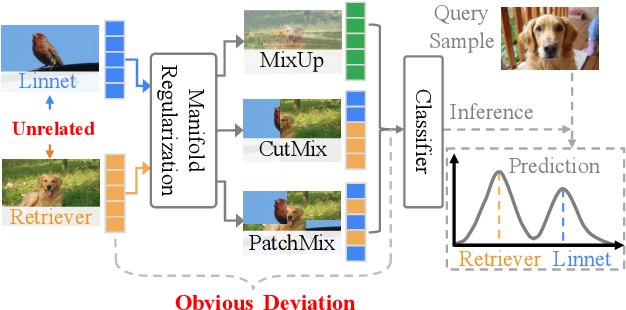
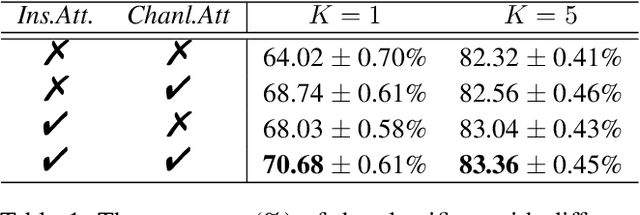

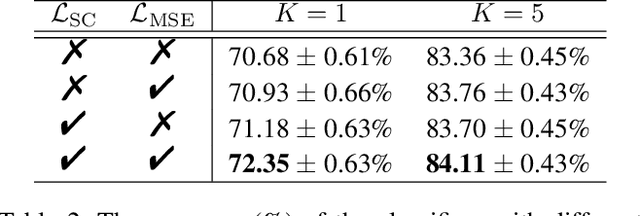
Abstract:Few-shot learning (FSL) based on manifold regularization aims to improve the recognition capacity of novel objects with limited training samples by mixing two samples from different categories with a blending factor. However, this mixing operation weakens the feature representation due to the linear interpolation and the overlooking of the importance of specific channels. To solve these issues, this paper proposes attentive feature regularization (AFR) which aims to improve the feature representativeness and discriminability. In our approach, we first calculate the relations between different categories of semantic labels to pick out the related features used for regularization. Then, we design two attention-based calculations at both the instance and channel levels. These calculations enable the regularization procedure to focus on two crucial aspects: the feature complementarity through adaptive interpolation in related categories and the emphasis on specific feature channels. Finally, we combine these regularization strategies to significantly improve the classifier performance. Empirical studies on several popular FSL benchmarks demonstrate the effectiveness of AFR, which improves the recognition accuracy of novel categories without the need to retrain any feature extractor, especially in the 1-shot setting. Furthermore, the proposed AFR can seamlessly integrate into other FSL methods to improve classification performance.
A Knowledge-Injected Curriculum Pretraining Framework for Question Answering
Mar 11, 2024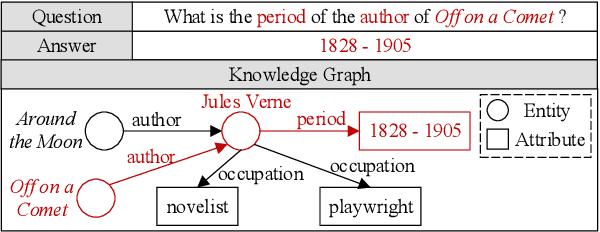
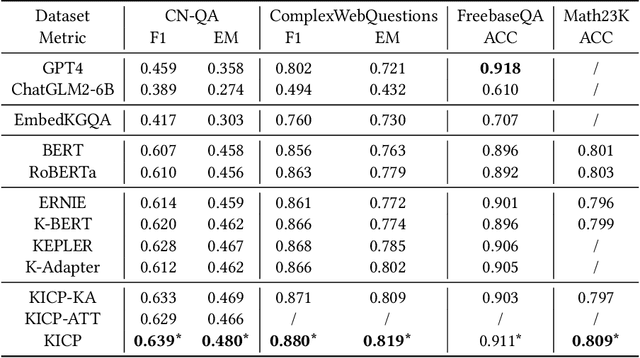
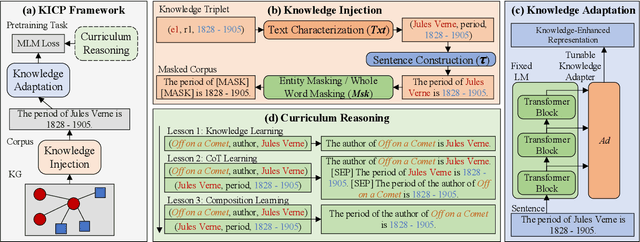
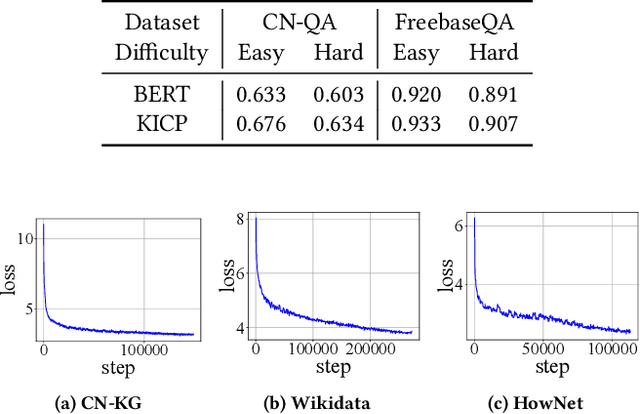
Abstract:Knowledge-based question answering (KBQA) is a key task in NLP research, and also an approach to access the web data and knowledge, which requires exploiting knowledge graphs (KGs) for reasoning. In the literature, one promising solution for KBQA is to incorporate the pretrained language model (LM) with KGs by generating KG-centered pretraining corpus, which has shown its superiority. However, these methods often depend on specific techniques and resources to work, which may not always be available and restrict its application. Moreover, existing methods focus more on improving language understanding with KGs, while neglect the more important human-like complex reasoning. To this end, in this paper, we propose a general Knowledge-Injected Curriculum Pretraining framework (KICP) to achieve comprehensive KG learning and exploitation for KBQA tasks, which is composed of knowledge injection (KI), knowledge adaptation (KA) and curriculum reasoning (CR). Specifically, the KI module first injects knowledge into the LM by generating KG-centered pretraining corpus, and generalizes the process into three key steps that could work with different implementations for flexible application. Next, the KA module learns knowledge from the generated corpus with LM equipped with an adapter as well as keeps its original natural language understanding ability to reduce the negative impacts of the difference between the generated and natural corpus. Last, to enable the LM with complex reasoning, the CR module follows human reasoning patterns to construct three corpora with increasing difficulties of reasoning, and further trains the LM from easy to hard in a curriculum manner. We provide an implementation of the general framework, and evaluate the proposed KICP on four real-word datasets. The results demonstrate that our framework can achieve higher performances.
TagCLIP: A Local-to-Global Framework to Enhance Open-Vocabulary Multi-Label Classification of CLIP Without Training
Dec 20, 2023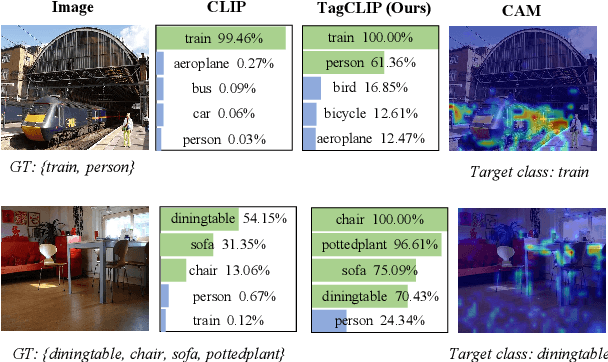

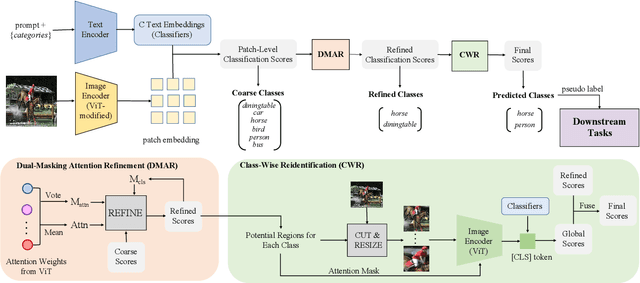
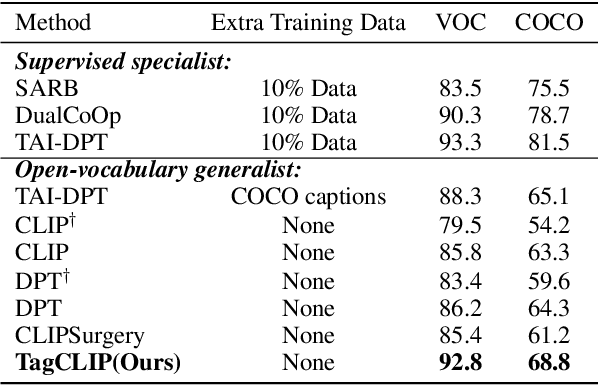
Abstract:Contrastive Language-Image Pre-training (CLIP) has demonstrated impressive capabilities in open-vocabulary classification. The class token in the image encoder is trained to capture the global features to distinguish different text descriptions supervised by contrastive loss, making it highly effective for single-label classification. However, it shows poor performance on multi-label datasets because the global feature tends to be dominated by the most prominent class and the contrastive nature of softmax operation aggravates it. In this study, we observe that the multi-label classification results heavily rely on discriminative local features but are overlooked by CLIP. As a result, we dissect the preservation of patch-wise spatial information in CLIP and proposed a local-to-global framework to obtain image tags. It comprises three steps: (1) patch-level classification to obtain coarse scores; (2) dual-masking attention refinement (DMAR) module to refine the coarse scores; (3) class-wise reidentification (CWR) module to remedy predictions from a global perspective. This framework is solely based on frozen CLIP and significantly enhances its multi-label classification performance on various benchmarks without dataset-specific training. Besides, to comprehensively assess the quality and practicality of generated tags, we extend their application to the downstream task, i.e., weakly supervised semantic segmentation (WSSS) with generated tags as image-level pseudo labels. Experiments demonstrate that this classify-then-segment paradigm dramatically outperforms other annotation-free segmentation methods and validates the effectiveness of generated tags. Our code is available at https://github.com/linyq2117/TagCLIP.
Reducing Idleness in Financial Cloud via Multi-objective Evolutionary Reinforcement Learning based Load Balancer
May 05, 2023Abstract:In recent years, various companies started to shift their data services from traditional data centers onto cloud. One of the major motivations is to save operation costs with the aid of cloud elasticity. This paper discusses an emerging need from financial services to reduce idle servers retaining very few user connections, without disconnecting them from the server side. This paper considers this need as a bi-objective online load balancing problem. A neural network based scalable policy is designed to route user requests to varied numbers of servers for elasticity. An evolutionary multi-objective training framework is proposed to optimize the weights of the policy. Not only the new objective of idleness is reduced by over 130% more than traditional industrial solutions, but the original load balancing objective is slightly improved. Extensive simulations help reveal the detailed applicability of the proposed method to the emerging problem of reducing idleness in financial services.
 Add to Chrome
Add to Chrome Add to Firefox
Add to Firefox Add to Edge
Add to Edge